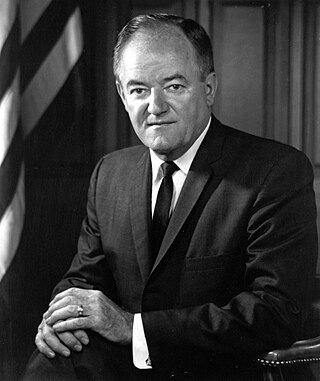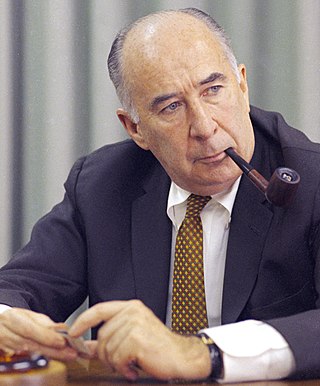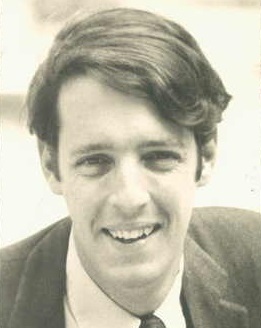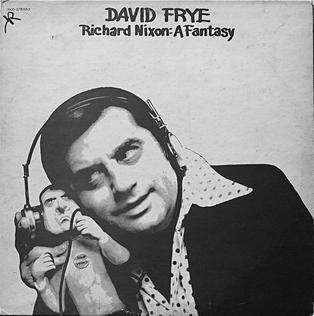
The 1968 United States presidential election was the 46th quadrennial presidential election, held on Tuesday, November 5, 1968. The Republican nominee, former vice president Richard Nixon, defeated the Democratic nominee, incumbent vice president Hubert Humphrey, and the American Independent Party nominee, former Alabama governor George Wallace.

Hubert Horatio Humphrey Jr. was an American pharmacist and politician who served as the 38th vice president of the United States from 1965 to 1969. He twice served in the United States Senate, representing Minnesota from 1949 to 1964 and 1971 to 1978. As a senator he was a major leader of modern liberalism in the United States. As President Lyndon B. Johnson's vice president, he supported the controversial Vietnam War. An intensely divided Democratic Party nominated him in the 1968 presidential election, which he lost to Republican nominee Richard Nixon.

John Newton Mitchell was the 67th Attorney General of the United States under President Richard Nixon and chairman of Nixon's 1968 and 1972 presidential campaigns. Prior to that, he had been a municipal bond lawyer and one of Nixon's closest personal friends. He was tried and convicted as a result of his involvement in the Watergate scandal.

Jeb Stuart Magruder was an American businessman and high-level political operative in the Republican Party who served time in prison for his role in the Watergate scandal.

Patricia Nixon Cox is the elder daughter of the 37th United States president Richard Nixon and First Lady Pat Nixon, and sister to Julie Nixon Eisenhower.

Fear and Loathing: On the Campaign Trail '72 is a 1973 book that recounts and analyzes the 1972 presidential campaign in which Richard Nixon was re-elected President of the United States. Written by Hunter S. Thompson and illustrated by Ralph Steadman, the book was largely derived from articles serialized in Rolling Stone throughout 1972.

The Canuck letter was a forged letter to the editor of the Manchester Union Leader, published February 24, 1972, two weeks before the New Hampshire primary of the 1972 United States presidential election. It implied that Senator Edmund Muskie, a candidate for the Democratic Party's presidential nomination, held prejudice against Americans of French-Canadian descent.

Joseph Ralph McGinniss Sr. was an American non-fiction writer and novelist.

David Shapiro was an American comedian, specializing in comic imitations of famous political figures, most of whom were based on notable Americans, including former U.S. Presidents Lyndon B. Johnson and Richard Nixon, Vice Presidents Hubert Humphrey, Spiro Agnew, and Nelson Rockefeller, and Senator Bobby Kennedy, as well as film celebrities, e.g., George C. Scott, Henry Fonda, Kirk Douglas, Robert Mitchum, Jack Nicholson, Jack Palance and Rod Steiger, and media figures, e.g., William F. Buckley Jr. and Larry King.
This bibliography of Richard Nixon includes publications by Richard Nixon, the 37th president of the United States, and books and scholarly articles about him and his policies.

From January 24 to June 20, 1972, voters of the Democratic Party chose its nominee for president in the 1972 United States presidential election. Senator George McGovern of South Dakota was selected as the nominee through a series of primary elections, caucuses, and state party conventions, culminating in the 1972 Democratic National Convention held from July 10 to July 13, 1972, in Miami, Florida.

The 1968 presidential campaign of Hubert Humphrey began when Vice President of the United States Hubert Humphrey of Minnesota decided to seek the Democratic Party nomination for President of the United States following President Lyndon B. Johnson's announcement ending his own bid for the nomination. Johnson withdrew after an unexpectedly strong challenge from anti-Vietnam War presidential candidate, Senator Eugene McCarthy of Minnesota, in the early Democratic primaries. McCarthy, along with Senator Robert F. Kennedy of New York, became Humphrey's main opponents for the nomination. Their "new politics" contrasted with Humphrey's "old politics" as the increasingly unpopular Vietnam War intensified.

The 1968 presidential campaign of Richard Nixon, the 36th vice president of the United States, began when Nixon, the Republican nominee of 1960, formally announced his candidacy, following a year's preparation and five years' political reorganization after defeats in the 1960 presidential election and the 1962 California gubernatorial election.
Theodore Harold White was an American political journalist and historian, known for his reporting from China during World War II and the Making of the President series.

The 1968 United States presidential election in New Mexico took place on November 5, 1968. All fifty states and The District of Columbia, were part of the 1968 United States presidential election. State voters chose four electors to represent them in the Electoral College, who voted for president and vice president.

The 1968 United States presidential election in Massachusetts took place on November 5, 1968, as part of the 1968 United States presidential election, which was held throughout all 50 states and D.C. Voters chose 14 representatives, or electors to the Electoral College, who voted for president and vice president.

Gabriel Sherman is an American author. In 2014, he wrote a biography about Fox News Channel president Roger Ailes called The Loudest Voice in the Room: How the Brilliant, Bombastic Roger Ailes Built Fox News – and Divided a Country, which debuted at #9 on The New York Times Bestseller list.

The 1968 United States presidential election in Utah took place on November 5, 1968, as part of the 1968 United States presidential election. State voters chose four representatives, or electors, to the Electoral College, who voted for president and vice president.

What Happened is a 2017 memoir by Hillary Clinton about her experiences as the Democratic Party's nominee and general election candidate for president of the United States in the 2016 election. Published on September 1, 2017, it is her seventh book with her publisher, Simon & Schuster.

The presidential transition of Richard Nixon began when he won the United States 1968 United States presidential election, becoming the president-elect, and ended when Nixon was inaugurated at noon EST on January 20, 1969. Nixon had become president-elect once the election results became clear on November 6, 1968, the day after the election. This was the first presidential transition to take place following the passage of the Presidential Transition Act of 1963.

















